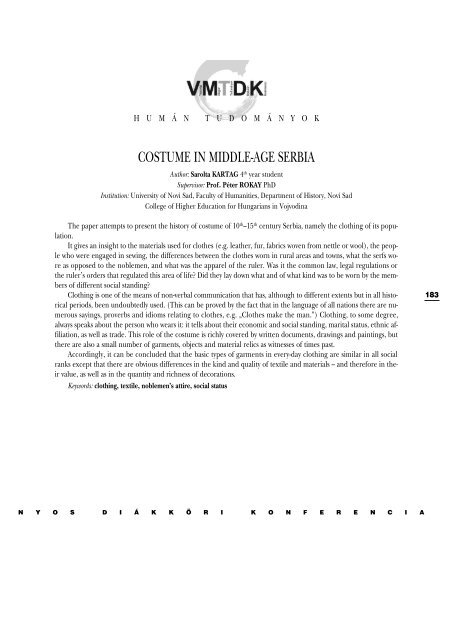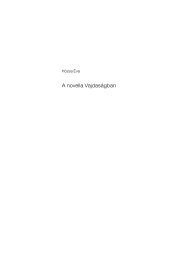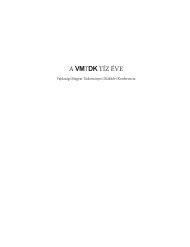Rezümékötet 2008. - vmtdk
Rezümékötet 2008. - vmtdk
Rezümékötet 2008. - vmtdk
You also want an ePaper? Increase the reach of your titles
YUMPU automatically turns print PDFs into web optimized ePapers that Google loves.
H U M Á N T U D O M Á N Y O K<br />
COSTUME IN MIDDLE-AGE SERBIA<br />
Author: Sarolta KARTAG 4 th year student<br />
Supervisor: Prof. Péter ROKAY PhD<br />
Institution: University of Novi Sad, Faculty of Humanities, Department of History, Novi Sad<br />
College of Higher Education for Hungarians in Vojvodina<br />
The paper attempts to present the history of costume of 10 th –15 th century Serbia, namely the clothing of its population.<br />
It gives an insight to the materials used for clothes (e.g. leather, fur, fabrics woven from nettle or wool), the people<br />
who were engaged in sewing, the differences between the clothes worn in rural areas and towns, what the serfs wore<br />
as opposed to the noblemen, and what was the apparel of the ruler. Was it the common law, legal regulations or<br />
the ruler’s orders that regulated this area of life? Did they lay down what and of what kind was to be worn by the members<br />
of different social standing?<br />
Clothing is one of the means of non-verbal communication that has, although to different extents but in all historical<br />
periods, been undoubtedly used. (This can be proved by the fact that in the language of all nations there are numerous<br />
sayings, proverbs and idioms relating to clothes, e.g. „Clothes make the man.”) Clothing, to some degree,<br />
always speaks about the person who wears it: it tells about their economic and social standing, marital status, ethnic affiliation,<br />
as well as trade. This role of the costume is richly covered by written documents, drawings and paintings, but<br />
there are also a small number of garments, objects and material relics as witnesses of times past.<br />
Accordingly, it can be concluded that the basic types of garments in every-day clothing are similar in all social<br />
ranks except that there are obvious differences in the kind and quality of textile and materials – and therefore in their<br />
value, as well as in the quantity and richness of decorations.<br />
Keywords: clothing, textile, noblemen’s attire, social status<br />
N Y O S D I Á K K Ö R I K O N F E R E N C I A<br />
183




